Abstract
Bryant, M. P. (U.S. Department of Agriculture, Beltsville, Md.) and I. M. Robinson. Some nutritional characteristics of predominant culturable ruminal bacteria. J. Bacteriol. 84:605–614. 1962.—The effect of enzymatic hydrolysate of casein, NH4+, a mixture of volatile fatty acids (acetic, n-valeric, isovaleric, 2-methylbutyric, and isobutyric), hemin, and ruminal fluid on growth of 89 freshly isolated strains of predominant culturable ruminal bacteria was studied, using basal media containing glucose, cellobiose, or maltose as energy source, minerals, cysteine, and S= as reducing agents, and H2CO3-HCO3− buffer. Of these strains, 13% (four morphological groups) grew poorly or not at all in defined medium plus casein hydrolysate; 6% (one morphological group) required casein hydrolysate; 56% (four morphological groups) grew with either NH4+ or casein hydrolysate as the main source of nitrogen; and NH4+, but not casein hydrolysate, was essential for 25% of the strains (five morphological groups). The volatile fatty acid mixture excluding acetate was essential for 19% of the strains (five morphological groups), and this mixture and acetate were necessary for good growth of 23% of the strains (one morphological group) when casein hydrolysate was excluded from the medium; 30% of the strains (one morphological group) required hemin. Similar studies are reported on 35 old laboratory strains of ruminal bacteria, most of which were previously identified. The results indicate that most strains of ruminal bacteria can be grown in defined media, and suggest the relative importance of NH4+ and volatile fatty acids and the relative lack of importance of organic nitrogen compounds such as amino acids in the nutrition of these bacteria.
Full text
PDF
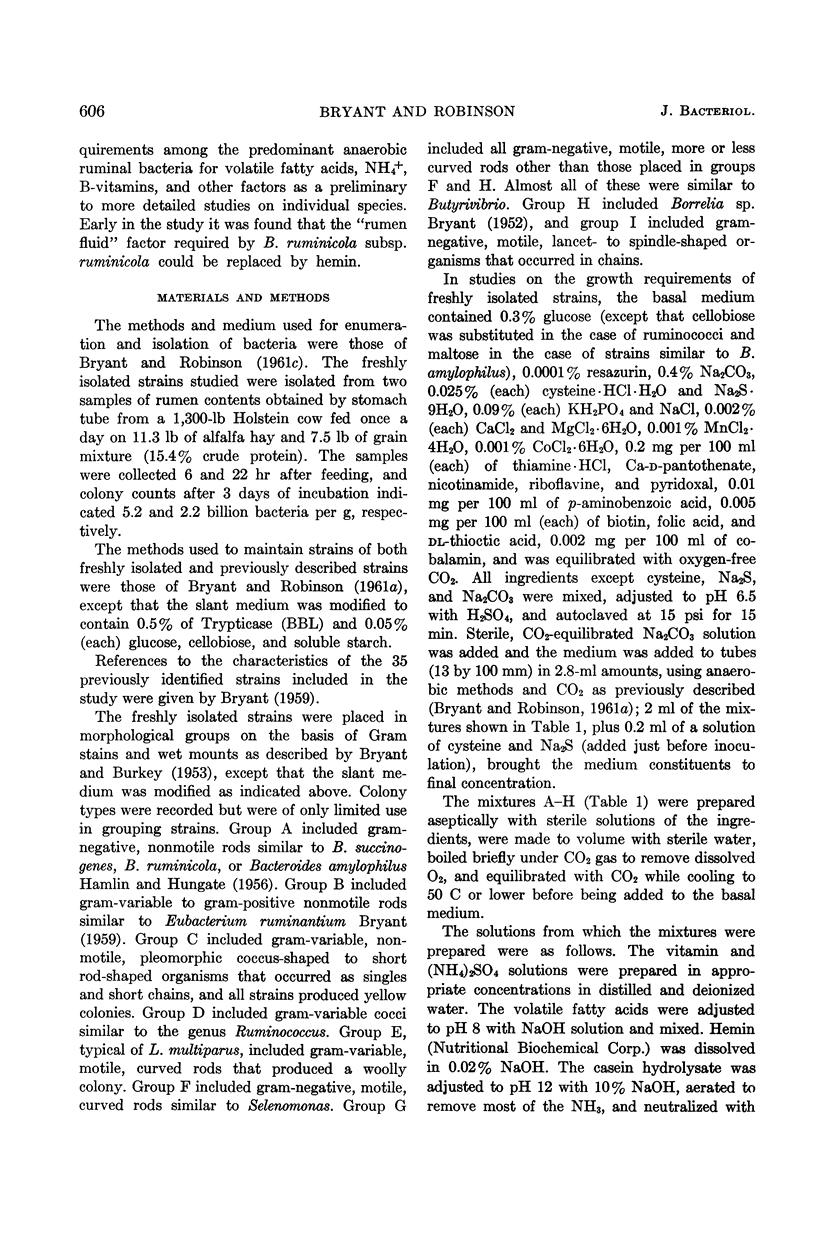
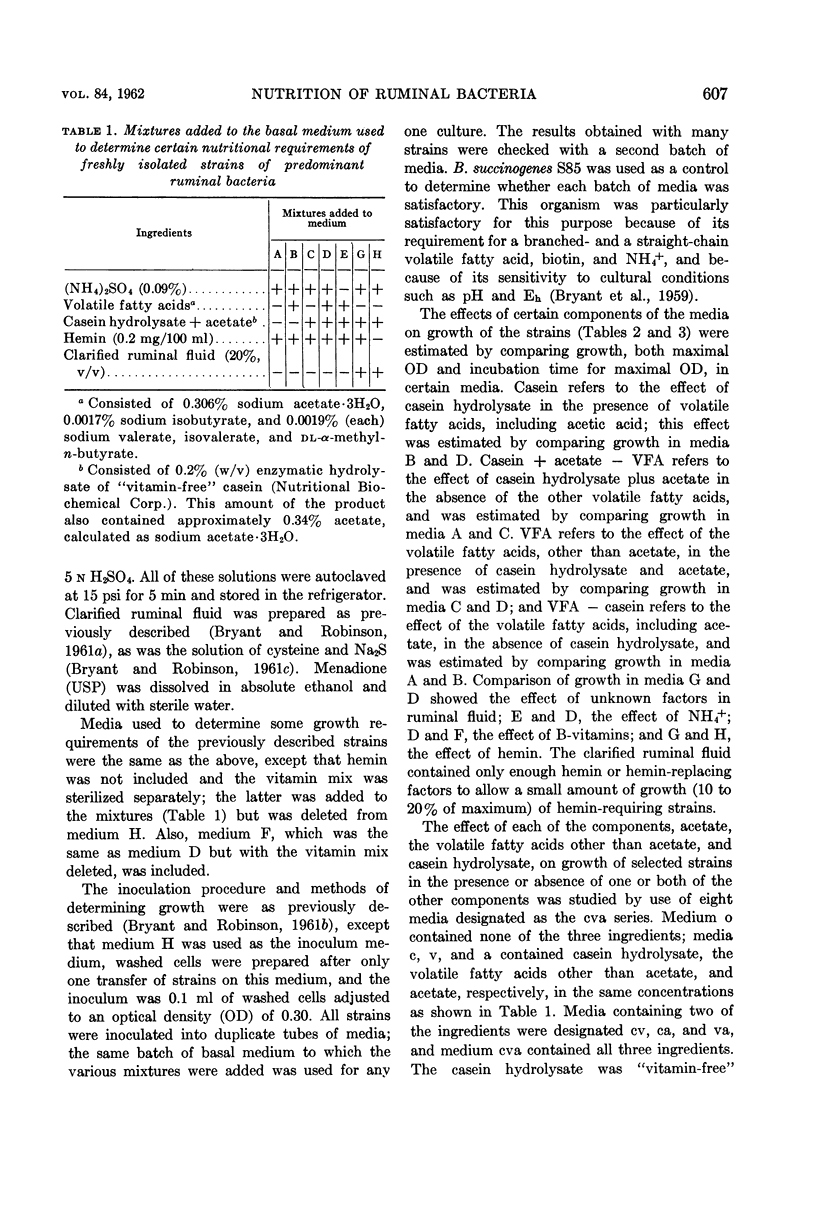
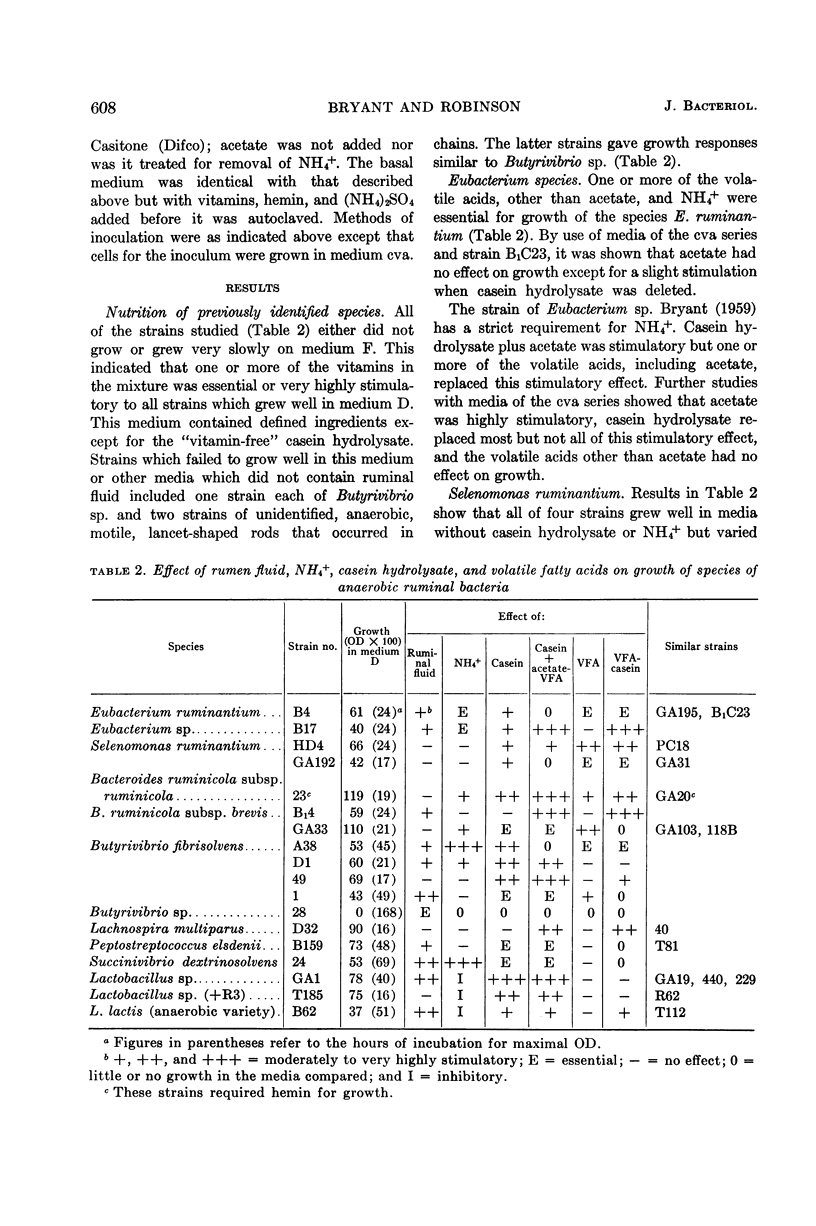
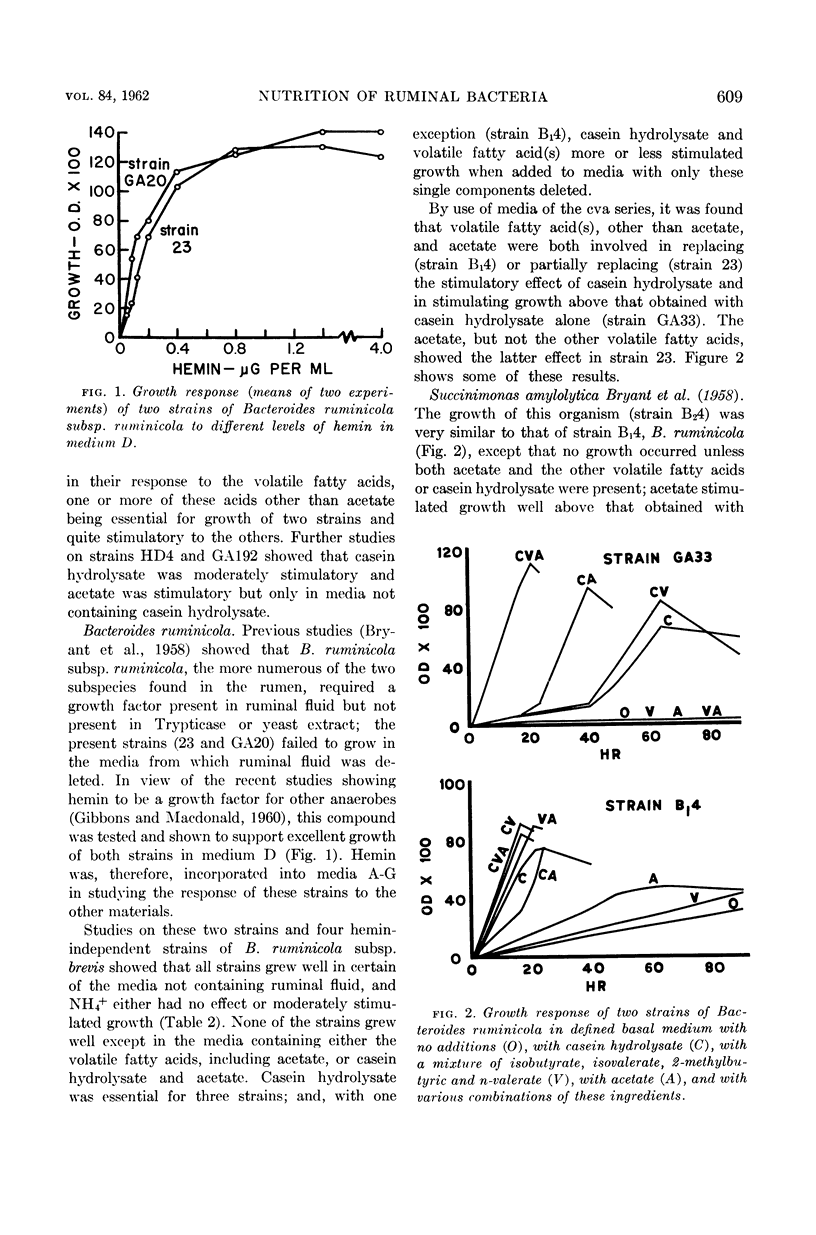




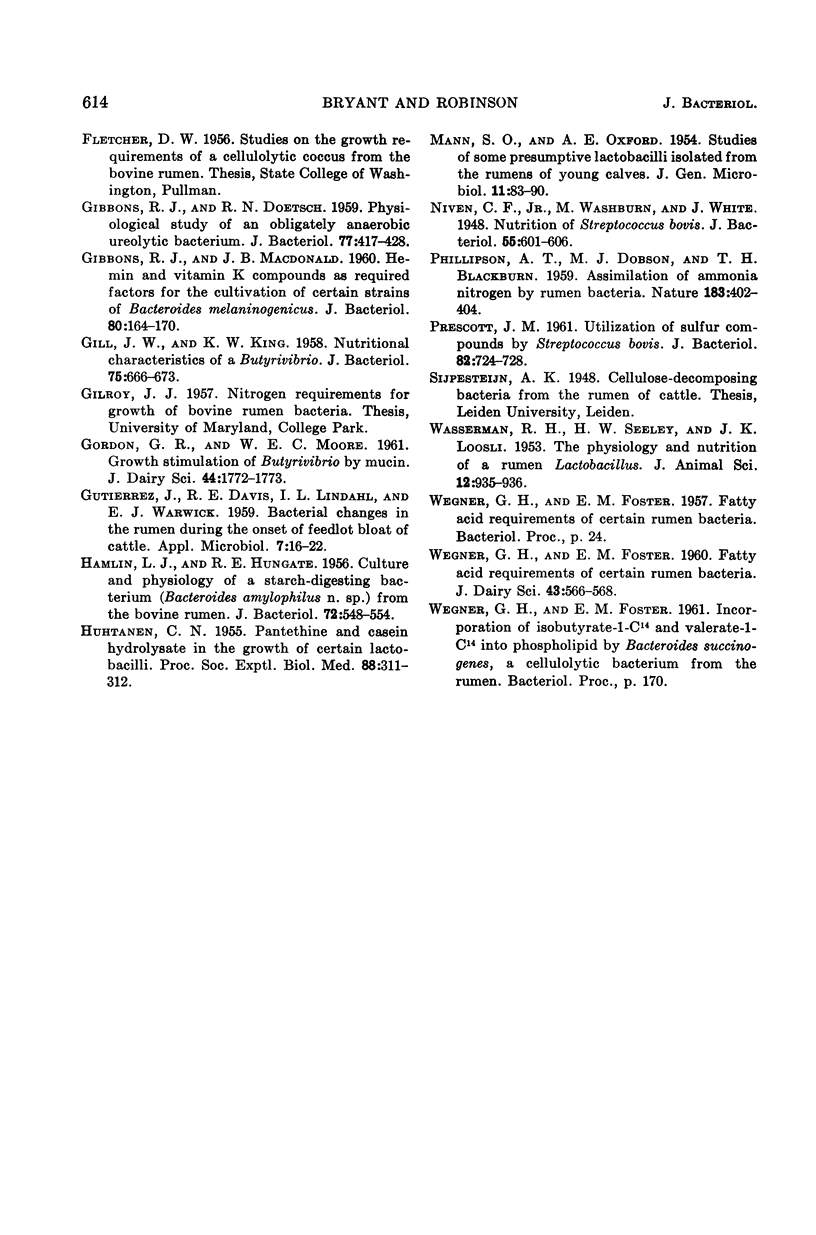
Selected References
These references are in PubMed. This may not be the complete list of references from this article.
- ALLISON M. J., BRYANT M. P., DOETSCH R. N. Studies on the metabolic function of branched-chain volatile fatty acids, growth factors for ruminococci. I. Incorporation of isovalerate into leucine. J Bacteriol. 1962 Mar;83:523–532. doi: 10.1128/jb.83.3.523-532.1962. [DOI] [PMC free article] [PubMed] [Google Scholar]
- ALLISON M. J., BRYANT M. P., DOETSCH R. N. Volatile fatty acid growth factor for cellulolytic cocci of bovine rumen. Science. 1958 Aug 29;128(3322):474–475. doi: 10.1126/science.128.3322.474. [DOI] [PubMed] [Google Scholar]
- ALLISON M. J., BRYANT M. P., KATZ I., KEENEY M. Metabolic function of branched-chain volatile fatty acids, growth factors for ruminococci. II. Biosynthesis of higher branched-chain fatty acids and aldehydes. J Bacteriol. 1962 May;83:1084–1093. doi: 10.1128/jb.83.5.1084-1093.1962. [DOI] [PMC free article] [PubMed] [Google Scholar]
- AYERS W. A. Nutrition and physiology of Ruminococcus flavefaciens. J Bacteriol. 1958 Nov;76(5):504–509. doi: 10.1128/jb.76.5.504-509.1958. [DOI] [PMC free article] [PubMed] [Google Scholar]
- BRYANT M. P. Bacterial species of the rumen. Bacteriol Rev. 1959 Sep;23(3):125–153. doi: 10.1128/br.23.3.125-153.1959. [DOI] [PMC free article] [PubMed] [Google Scholar]
- BRYANT M. P., SMALL N., BOUMA C., CHU H. Bacteroides ruminicola n. sp. and Succinimonas amylolytica; the new genus and species; species of succinic acid-producing anaerobic bacteria of the bovine rumen. J Bacteriol. 1958 Jul;76(1):15–23. doi: 10.1128/jb.76.1.15-23.1958. [DOI] [PMC free article] [PubMed] [Google Scholar]
- BRYANT M. P., SMALL N. Characteristics of two new genera of anaerobic curved rods isolated from the rumen of cattle. J Bacteriol. 1956 Jul;72(1):22–26. doi: 10.1128/jb.72.1.22-26.1956. [DOI] [PMC free article] [PubMed] [Google Scholar]
- BRYANT M. P., SMALL N. The anaerobic monotrichous butyric acid-producing curved rod-shaped bacteria of the rumen. J Bacteriol. 1956 Jul;72(1):16–21. doi: 10.1128/jb.72.1.16-21.1956. [DOI] [PMC free article] [PubMed] [Google Scholar]
- BRYANT M. P. The isolation and characteristics of a spirochete from the bovine rumen. J Bacteriol. 1952 Sep;64(3):325–335. doi: 10.1128/jb.64.3.325-335.1952. [DOI] [PMC free article] [PubMed] [Google Scholar]
- Bryant M. P., Robinson I. M. Some Nutritional Requirements of the Genus Ruminococcus. Appl Microbiol. 1961 Mar;9(2):91–95. doi: 10.1128/am.9.2.91-95.1961. [DOI] [PMC free article] [PubMed] [Google Scholar]
- Bryant M. P., Robinson I. M. Studies on the Nitrogen Requirements of Some Ruminal Cellulolytic Bacteria. Appl Microbiol. 1961 Mar;9(2):96–103. doi: 10.1128/am.9.2.96-103.1961. [DOI] [PMC free article] [PubMed] [Google Scholar]
- EMERY R. S., SMITH C. K., FAI TO L. Utilization of inorganic sulfate by rumen microorganisms. II. The ability of single strains of rumen bacteria to utilize inorganic sulfate. Appl Microbiol. 1957 Nov;5(6):363–366. doi: 10.1128/am.5.6.363-366.1957. [DOI] [PMC free article] [PubMed] [Google Scholar]
- GIBBONS R. J., DOETSCH R. N. Physiological study of an obligately anaerobic ureolytic bacterium. J Bacteriol. 1959 Apr;77(4):417–428. doi: 10.1128/jb.77.4.417-428.1959. [DOI] [PMC free article] [PubMed] [Google Scholar]
- GIBBONS R. J., MACDONALD J. B. Hemin and vitamin K compounds as required factors for the cultivation of certain strains of Bacteroides melaninogenicus. J Bacteriol. 1960 Aug;80:164–170. doi: 10.1128/jb.80.2.164-170.1960. [DOI] [PMC free article] [PubMed] [Google Scholar]
- GILL J. W., KING K. W. Nutritional characteristics of a Butyrivibrio. J Bacteriol. 1958 Jun;75(6):666–673. doi: 10.1128/jb.75.6.666-673.1958. [DOI] [PMC free article] [PubMed] [Google Scholar]
- GUTIERREZ J., DAVIS R. E., LINDAHL I. L., WARWICK E. J. Bacterial changes in the rumen during the onset of feed-lot bloat of cattle and characteristics of Peptostreptococcus elsdenii n. sp. Appl Microbiol. 1959 Jan;7(1):16–22. doi: 10.1128/am.7.1.16-22.1959. [DOI] [PMC free article] [PubMed] [Google Scholar]
- HAMLIN L. J., HUNGATE R. E. Culture and physiology of a starch-digesting bacterium (Bacteroides amylophilus n. sp.) from the bovine rumen. J Bacteriol. 1956 Oct;72(4):548–554. doi: 10.1128/jb.72.4.548-554.1956. [DOI] [PMC free article] [PubMed] [Google Scholar]
- HUHTANEN C. N. Pantethine and casein hydrolyzate in the growth of certain lactobacilli. Proc Soc Exp Biol Med. 1955 Feb;88(2):311–312. doi: 10.3181/00379727-88-21572. [DOI] [PubMed] [Google Scholar]
- MANN S. O., OXFORD A. E. Studies of some presumptive lactobacilli isolated from the rumens of young calves. J Gen Microbiol. 1954 Aug;11(1):83–90. doi: 10.1099/00221287-11-1-83. [DOI] [PubMed] [Google Scholar]
- Niven C. F., Jr, Washburn M. R., White J. C. Nutrition of Streptococcus bovis. J Bacteriol. 1948 May;55(5):601–606. doi: 10.1128/jb.55.5.601-606.1948. [DOI] [PMC free article] [PubMed] [Google Scholar]
- PHILLIPSON A. T., DOBSON M. J., BLACKBURN T. H. Assimilation of ammonia nitrogen by rumen bacteria. Nature. 1959 Feb 7;183(4658):402–404. doi: 10.1038/183402a0. [DOI] [PubMed] [Google Scholar]
- PRESCOTT J. M. Utilization of sulfur compounds by Streptococcus bovis. J Bacteriol. 1961 Nov;82:724–728. doi: 10.1128/jb.82.5.724-728.1961. [DOI] [PMC free article] [PubMed] [Google Scholar]


